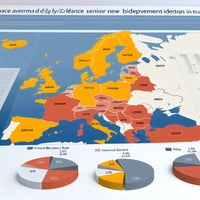Introduction The consultancy industry has long been a cornerstone of business strategy and...
Rise and Fall of DEC: Lessons in Adaptability and Strategic Foresight
 In 1957, Digital Equipment Corporation (DEC) was founded by Ken Olsen and Harlan Anderson. Over the next few decades, DEC became a trailblazer in computer technology, revolutionizing the industry with its innovative minicomputers like the PDP (Programmed Data Processor) and VAX (Virtual Address eXtension) series. At its peak in the 1980s, DEC was the second-largest computer company in the world, employing tens of thousands of people and challenging IBM's dominance.
In 1957, Digital Equipment Corporation (DEC) was founded by Ken Olsen and Harlan Anderson. Over the next few decades, DEC became a trailblazer in computer technology, revolutionizing the industry with its innovative minicomputers like the PDP (Programmed Data Processor) and VAX (Virtual Address eXtension) series. At its peak in the 1980s, DEC was the second-largest computer company in the world, employing tens of thousands of people and challenging IBM's dominance.
However, DEC's meteoric rise was followed by an equally dramatic decline. The company, once an industry leader, was acquired by Compaq in 1998 for $9.6 billion. Today, DEC’s story serves as a powerful lesson in the importance of adaptability, strategic foresight, and leadership in an ever-changing business environment.
The Rise of DEC: A Revolution in Computing
In the 1960s and 1970s, the computing landscape was dominated by large, expensive mainframes used primarily by governments and large corporations. DEC disrupted this status quo by introducing smaller, affordable minicomputers that offered powerful computing capabilities to medium-sized businesses, universities, and research institutions.
The PDP-8 and PDP-11 models became iconic, and the VAX series cemented DEC's reputation as an industry leader. With these innovations, DEC allowed organizations to harness computing power without the massive infrastructure required by mainframes.
But the seeds of future challenges were already being sown. As the market shifted toward personal computers (PCs) in the 1980s, driven by companies like Apple, IBM, and Microsoft, DEC was slow to react.
The Missed Opportunity: Ignoring the PC Revolution
The rapid rise of PCs, powered by microprocessors, transformed the computing industry. Personal computers were affordable, portable, and accessible, making them attractive to small businesses, schools, and eventually households. Companies like IBM and Apple capitalized on this trend, redefining how technology was used globally.
Ken Olsen and DEC’s leadership, however, viewed PCs as inferior to their high-performance minicomputers. Olsen infamously stated that he saw no reason why anyone would want a computer in their home. This underestimation of the PC market’s potential resulted in DEC's failure to invest early in this critical growth area.
When DEC eventually attempted to enter the PC market, its efforts were poorly executed. Products like the DEC Rainbow—a hybrid system compatible with both CP/M and MS-DOS—failed to gain traction in a competitive landscape dominated by IBM, Dell, and Compaq.
Strategic Failures and Internal Challenges
DEC's downfall was not just due to misjudging the PC revolution. Several internal issues exacerbated the company’s struggles:
-
Product Line Complexity:
DEC developed multiple incompatible platforms, which confused customers and drove up development costs. Instead of streamlining its portfolio, the company overextended itself. -
Decentralized Structure:
DEC’s divisions operated independently, making it difficult to coordinate strategic initiatives. This lack of alignment hindered innovation and responsiveness to market changes. -
Late Diversification Attempts:
By the time DEC realized the importance of personal computing, its competitors had already secured significant market share. DEC’s belated and half-hearted attempts to diversify were unsuccessful. -
Increased Competition:
Companies like Dell revolutionized the industry with direct-to-consumer sales and just-in-time manufacturing, which enabled faster delivery and lower prices. DEC was unable to keep up with these agile competitors. -
Leadership Blind Spots:
Ken Olsen’s resistance to change and failure to embrace emerging technologies ultimately limited DEC’s ability to evolve with the market. DEC’s leadership missed critical opportunities to pivot and innovate.
What DEC Could Have Done Differently
To avoid its downfall, DEC could have implemented several strategic changes:
-
Adapt to Market Trends:
By monitoring technological advancements and shifting consumer needs, DEC could have identified the rise of personal computers as a key opportunity. -
Simplify and Standardize Products:
A streamlined portfolio with compatible platforms would have reduced costs and improved customer experience, allowing DEC to focus on core innovations. -
Invest in the PC Market Early:
Entering the PC market early with competitive products could have positioned DEC as a leader alongside IBM and Apple. -
Develop Agile Leadership:
DEC needed leaders who were open to new ideas and willing to take calculated risks. A more diverse leadership team might have brought fresh perspectives to guide the company through technological disruptions. -
Explore Strategic Partnerships:
Collaborating with tech giants like Microsoft or Intel could have provided DEC with valuable insights and access to key markets. -
Optimize Business Models:
Adopting innovative sales strategies, such as direct-to-consumer models, could have helped DEC compete with companies like Dell. -
Pivot to Software and Services:
As hardware became commoditized, DEC could have expanded its focus on enterprise software, consulting, and network services to create new revenue streams.
The Fall and Legacy
By the early 1990s, DEC was in financial distress, losing ground to faster, more adaptable competitors. In a last-ditch effort to survive, the company restructured, laying off employees and selling non-core assets. Despite these efforts, DEC could not recover and was acquired by Compaq in 1998. Ironically, Compaq itself would later be absorbed by Hewlett-Packard (HP) in 2002.
DEC’s story is a powerful reminder of how quickly success can turn to failure without continuous innovation and strategic flexibility. Its rise and fall offer enduring lessons for businesses today, particularly in industries defined by rapid technological change.
Key Lessons for Today’s Businesses
-
Adaptability is Crucial:
Companies must constantly monitor market trends and be willing to pivot in response to technological disruption. -
Customer-Centric Innovation:
Even the most advanced technology is meaningless if it does not meet market demand. Businesses must align their innovations with customer needs. -
Agile Leadership and Vision:
Leaders must foster a culture of innovation and openness to new ideas. Sticking to outdated beliefs can hinder growth and competitiveness. -
Strategic Focus and Alignment:
Large organizations must balance decentralization with coordinated strategies to remain agile and responsive to market shifts.
Conclusion
The rise and fall of Digital Equipment Corporation is a cautionary tale of both triumph and tragedy. As industries continue to evolve at lightning speed, companies must remain vigilant, adaptive, and innovative to thrive. DEC’s legacy, while marked by missed opportunities, serves as a vital case study in how businesses can navigate the complex landscape of technological disruption and transformation.



